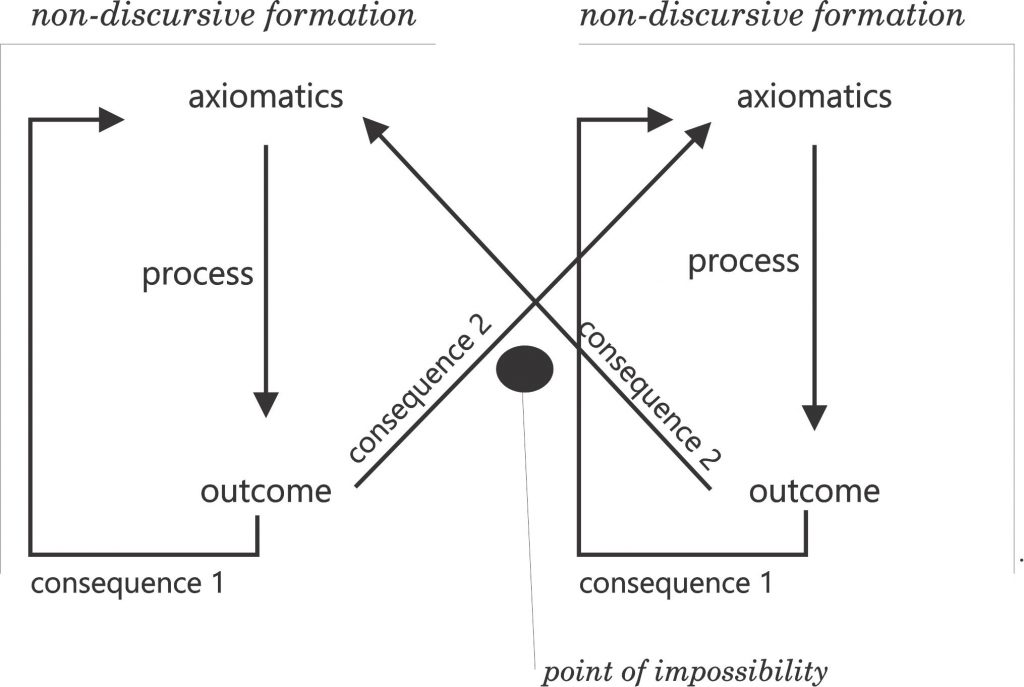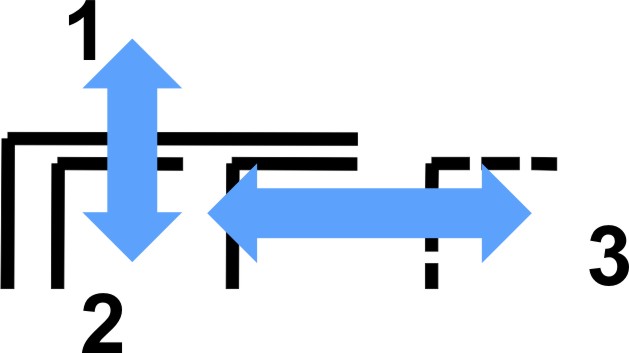by Philip Boxer
An earlier blog on dilemmas as drivers of change introduced the notion of an impossibility lying between the horns of a dilemma:

These impossibilities emerge in the course of our efforts to organize the behaviors of an enterprise that in some way reflect our interests – we use the enterprise in support of our identifications while at the same time being used. There may, therefore, be some objective basis for the presence of an impossibility between the horns of a dilemma that we are experiencing. Through our entanglement with the situations in which we are experiencing, however, the dilemma with its impossibility is also an extimate symptom of the way we are taking up our being.
As such, these impossibilities underlying a dilemma are not the ‘impossibilities’ of which Lacan speaks with reference to the relation between the places of ‘agent’ and ‘work’ in the four discourses (Lacan 2009; Fierens 2002). They are the impotence (Lacan 2007[1969-70]: p191 ff) that characterizes the relation between ‘truth’ and production in the quadripod structure of a discourse (the dotted line):

I found a way of approaching the nature of this impotence in Shoshana Felman’s reading of Freud’s reading of Irma’s dream (Freud 1953[1900]: p106 ff). This appears in her book ‘What Does A Woman Want?’ in the chapter on ‘Competing Pregnancies: The Dream from which Psychoanalysis Proceeds’ (Felman 1993: pp68-120).
The subtitle of this book is ‘Reading and Sexual Difference’, and it is in these terms that the impotence of ‘truth’, as Lacan refers to it, is read more like the relation to the navel of the dream as Freud speaks of it (Freud 1953[1900]: p 111, note 1). Felman’s reading starts from a “first-stage” feminist interpretation of “the habitual masculine bias of Freud’s own terms and diction” (Felman 1993: p82):
“Freud’s rhetorical address seems to imply that the question of femininity, while involving women (“they are themselves this riddle”), in effect addresses only men. The question of femininity becomes thus, in effect, a question of complicity among men: a question of the complicity of men about the fact that the question of the Woman is their exclusive question.” (Felman 1993: p81, italics in original)
Felman contrasts this with a “second-stage” interpretation that she argues should be of that which remains ‘other’ to the first-stage interpretation, while still remaining present/implicated by the same underlying material:
“… if the Irma dream bears witness to what we may call, indeed, a male sleep – a narcissistic, wish-fulfilling sleep – it also, at the same time, dramatizes male insomnia: male restlessness in the face of unsatisfactory male solutions, and the refusal of the sleep – insomniac with dreams – to sleep away the problems. The challenge, I believe, for feminists today, and the question of a “second-stage” female reinterpretation of Freud’s dream, is how to relate differentially to this male dream, by specifically encroaching on, and situating, its male insomnia. The challenge for a “second-stage” feminist and Freudian dream-critique is, I would suggest, to analyse and articulate, in male dreams, the female lessons of their male insomnia. By engaging in an analytic dialogue with the dream’s self-analytic dialogue, with the dream’s own self-debate, with its difference from itself, women should be asking – sympathetically yet critically, critically yet sympathetically – “What does Freud want?” in the same challenging, creative, and imaginative way that Freud has asked” “What dies a woman want?” “ (Felman 1993: pp98-99, italics in original)
This leads to an understanding of the dream as pregnant with a difference between these ‘first-stage’ and ‘second-stage’ readings that is in itself generative (in the sense of engendering):
“to conceive psychoanalysis from Irma is thus an altogether different thing than to conceive psychoanalysis from Fleiss. And the pregnancy of the Irma dream is pregnant with something new only insofar as it is pregnant with this difference. If, unlike Erikson, the dreamer knows it is impossible to do away with, to give birth without, the female patient, it is because psychoanalysis is here conceived (and this is the discovery the dream is pregnant with) less as a new “solution” (a new science, a new theory) than as a radically new praxis of relating, and as a radically new praxis of relating theory and practice: “solutions” and their dialogic procreation.(Felman 1993: p112, italics in original)
From here she reads Freud’s navel of the dream not so much as an ‘interpretation’ per se, as an articulating of the radically unconscious ‘questioning’ that the dream makes present. The generativity of the dream is not of a general nature, but particular to the moment of the dreaming and its relation to this navel:
“Why, indeed, does Freud choose to call “navel” the dream’s relationship to the unknown? The navel marks the place where the umbilical cord is first attached and then (during delivery) cut off; it marks, in other words, at once the disconnection and the connection between a maternal body giving birth and a newborn child. The navel of the dream embodies, thus, the way in which the dream is, all at once, tied up with the unknown and disconnected from its knowledge, disconnected from the knowledge of its own begetting.(Felman 1993: p113, italics in original)
This positions the origin of Freud’s self-analysis in the triadic movement from an initial first-stage assertion to the second-stage uncovering of its implicit ‘other-ing’ – in a sense the foregrounding of a dilemma – that are together situated in a third mooting of a radically unconscious navel made present by the movement between a one (the Yad’lun of Lacan (Lacan 2016[2005]: p50)) and an ‘other-ed’, this back-and-forth movement being symptomatic of the underlying problematic that the dilemma makes present in all its particularity:
“Freud discovers, thus, as yet unconsciously, the very origin of self-analysis, the very motivating force of analytic dialogue, in the oneirically unfolded navel of sexuality as difference: of sexuality as the ungraspable, intuited relation between the navel of “bashful” pregnant belly and the choking, strangling knot of pain in Irma’s throat. As the ungraspable foundation of a radical unconscious dramatized by the complex, dramatic figure of the pregnant navel/knot in Irma’s throat, sexuality is, in the Irma dream, envisioned as a double reference – a connection/disconnection – on the one hand, to the body, and on the other hand to speech.”(Felman 1993: p118, italics in original)
This graphic from the double challenge working through the tension between meaning and motivation introduces the ‘other-ing’ in the ‘3’ relation to the ‘1-2’ framing of the initial ‘one’:

Understood in this way, the denial of this ‘other-ing’ relation, whether by turning a blind eye to it within an existing framing, or by discluding it by leaving it wholly ‘other’, are both strategies for avoiding being challenged by an underlying impotence – a challenge which, if faced, would lead to some form of disruption to the pre-existing way in which the subject takes up his or her being.[1]
This challenge involves facing a third crisis, going though which initiates a new cycle.
[1] This refusal to accept the challenge of the impotence refers to minding the gap and the three moments within the third moment. The initial response to the impotence is ‘don’t blame me’: “Stop. I can go no further. Not another word. It’s just not possible for me to go any further, and I am going to have to make do with what I have.” The next response is ‘turning a blind eye’: “What do you want of me? What do you expect of me? Who are you to expect more to be done by me. Don’t you see how much I have done already? Stop making problems for me.” The third response is to ‘disclude’ (dismiss and exclude): “What do I want? What am I prepared to do about this situation that feels so wrong? I would have to go beyond what I know here if I was to try and do something more – this is not my problem and not my fight.” The third crisis, then, is to choose not to scapegoat/split, not to turn a blind eye and not to disclude, but to innovate as if knowing what to do while knowing that I do not know… to pay with my being.
References
Felman, Shoshana. 1993. What does a woman want? Reading and Sexual Difference (The John Hopkins University Press: Baltimore and London).
Fierens, Christian. 2002. Lecture de l’étourdit – Lacan 1972 (L’Harmattan: Paris).
Freud, S. 1953[1900]. ‘The Interpretation of Dreams (First Part).’ in J. Strachey (ed.), The Standard Edition of the Complete Psychological Works of Sigmund Freud Volume IV (The Hogarth Press and the Institute of Psycho-Analysis: London).
Lacan, J. 2007[1969-70]. The Other Side of Psychoanalysis: Book XVII (W.W. Norton & Company: New York).
———. 2009. ‘L’etourdit’, The Letter, 41: 31-80.
———. 2016[2005]. Jacques Lacan: The Sinthome. The Seminar of Jacques Lacan Boox XXIII 1975-1976 (Polity: Cambridge, UK).